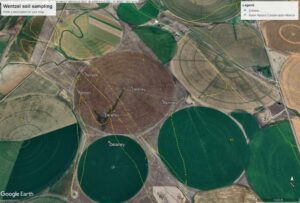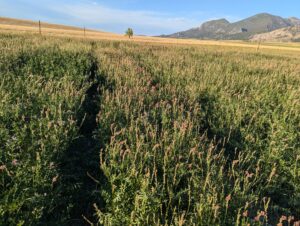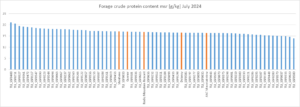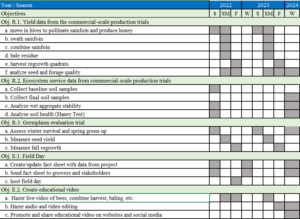Final report for FW22-390
Project Information
The Land Institute has been researching sainfoin as a candidate perennial pulse crop since 2017, but sainfoin has already been used in Conservation Reserve Program plantings and as a perennial hay and grazing crop for 50+ years in MT. This project asks “Is sainfoin ready to be grown as a perennial pulse MT using common forage-type varieties?” and “Could managing sainfoin as a dual purpose pulse and forage crop allow for early and low-risk, adoption by MT farmers until new pulse-type varieties are developed?” We propose to 1) document seed, forage, and honey yield and quality from six commercial sainfoin fields of three common forage-type varieties, 2) document changes in soil health parameters over the project period, and 3) compare yields of common forage-type varieties to experimental pulse-type varieties selected at The Land Institute.
We will collaborate with The Land Institute’s sainfoin breeder to generate sainfoin yield potential and ecosystem services market data needed to attract investment from food companies and interest from other researchers in this sustainable crop. We will share our findings through fact-sheets, a field day, and youtube and social media. We hope that this project provides other farmers and ranchers with the knowledge needed to grow and sell this novel pulse crop. Despite yields that may be lower than other common annual pulses grown in MT, we expect sainfoin will be a viable option because of its resiliency over multiple years and the multiple income streams it can provide as an integrated crop-livestock system.
Research Objectives: Determine the viability of sainfoin as a perennial pulse in MT.
Objective R.1. Evaluate seed/grain yields, biomass yields, honey yields, and grain/forage quality of common forage-type sainfoin varieties in MT at commercial scales.
Objective R.2. Evaluate effects of sainfoin on soil health and carbon sequestration.
Objective R.3. Compare the persistence, yield, and adaptability of experimental sainfoin pulse populations compared to common forage-type varieties.
Education Objectives: Improve farmer and stakeholder knowledge of sainfoin as a forage and potential pulse.
Objective E.1. Host an on-farm demonstration/field day in Twin Bridges, MT.
Objective E.2. Publish findings about sainfoin yields and ecosystem services in fact sheets and youtube videos.
Please see the Gantt chart for a timeline of activities.
Milestones include:
- Sending out initial fact sheets to growers/ranchers, food companies, and conservation stakeholders like the NRCS.
- Collecting baseline and final soil samples
- Harvesting sainfoin seeds and biomass from commercial-scale and germplasm evaluation plots
- Hosting a field day in 2022
- Finishing up a sainfoin pulse promotional video (2024)
- Creating final fact sheets and other documentation with analyzed and interpreted data from the study.
Cooperators
- - Technical Advisor (Researcher)
Research
Objective R.1. Measure and compare seed and grain yields and quality, biomass yields and quality, and honey yields of common sainfoin varieties grown at commercial scales to determine the viability of sainfoin as a dual-purpose perennial pulse crop in MT.
Materials and Methods:
This study occurred within six commercial sainfoin fields, two fields each of forage type varieties Delaney, Remont, and AAC Mountainview during 2022 and 2023. Each field was at least 10 acres in size.
We moved honeybee hives (2 hives per acre) to each field in late spring once the sainfoin begins to bloom and left them in the fields for approximately 2 months through the full bloom period. Honey yields were recorded for both years.
In early August, we swathed the sainfoin plots when at least 30% of the pods had turned brown and combined with a pickup header when dry. Total seed yields were recorded and a 50lb subsample from each plot was delivered to The Land Institute. At The Land Institute, the samples were dehulled and tested for measure basic nutritional attributes (protein, ash, moisture, oil, fiber), and screened for potential mycotoxins (aflatoxin, ochratoxin, etc.).
Immediately after harvesting seed, we baled the straw/residue, counted the bales per plot and estimated the total straw weight per field using the total bales and average bale weight. We took core samples from a subset of bales in each field and submited them for complete forage analysis (moisture, CP, ADF, NDF, fat, ash, lignin, starch, RFV, TDN, etc.).
Objective R.2. Evaluate effects of sainfoin production on soil health and carbon sequestration.
Materials and Methods:
We took soil samples at 0-6 inch depths from the six commercial fields in April 2022 and March 2024 to evaluate changes in soil health. Soil health metrics were estimated for each field using the Haney Test. Although the small number of samples and short period of time made estimating changes in soil health within the sainfoin fields difficult to observe over time, we characterized the differences among soil types in these fields.
Objective R.3. Compare the persistence, yield, and adaptability of experimental sainfoin populations compared to common forage-type varieties.
Materials and Methods:
We established a small plot germplasm evaluation using an augmented block design in June 2023. The four existing sainfoin forage varieties - Delaney, Remont, and AAC Mountainview, Shoshone - and 'Gunner' alfalfa were used as checks replicated in each block with twelve additional unreplicated plots of sainfoin half-sib progeny populations. Each plot was be 4ft x 10ft in size. In total we planted and evaluate 155 half-sib populations.
During the 2024 growing season, employees from The Land Institute traveled to the site and harvested the plots using a plot forage harvester in July and September. Forage yield was estimated for each plot using a scale on the forage harvester, and forage subsamples were submitted to Dairyland Laboratories to estimate forage quality characteristic for each plot. The study design will allowed accurate yield estimates and comparisons among the four replicated forage varieties. These statistical comparisons could not be made in the Obj 1 commercial-scale experiment. The design also allowed for a baseline understanding of the unreplicated experimental germplasm and for making selections that could be used to breed superior sainfoin dual-purpose pulse and forage varieties for the region.
Obj R1. Field Scale Trials
Seed Production
In 2022, water limitations due to drought conditions allowed us to harvest sainfoin seed from only three of six fields with adequate irrigation. These fields produced average yields of 1,100, 500, and 800 lb/acre, respectively. In 2023, however, improved water availability enabled higher yields across most fields, with averages ranging from 700 to 1,000 lb/acre. After dehulling (removal of the seed pods) at The Land Institute, we found that the pod accounted for roughly 35% of the total seed weight. Consequently, our effective yields ranged from approximately 325 to 715 lb/acre—around 50% of Montana’s average irrigated lentil yields.
In 2023, one production field had a notably low yield of approximately 225 lb/acre, likely due to limited irrigation and severe pest pressure. Grasshoppers were prevalent during late bloom and seed fill stages, contributing to yield loss, while chalcid wasps posed a significant threat. These wasps lay eggs in developing sainfoin seeds, with larvae causing damage that results in infertile and non-consumable seeds. We estimate that up to 30% of seeds in this field were affected by chalcid wasp activity, highlighting a potential challenge for sainfoin production in the western U.S. To address these pest issues, integrated pest management (IPM) strategies and evaluation and approval of insecticides for sainfoin pulse production will be essential for sustaining a reliable sainfoin supply chain in this region.
Subsamples of the harvested sainfoin seeds from commercial varieties were dehulled at The Land Institute and analyzed by Great Plains Analytical Labs (GPAL). The seeds demonstrated high nutritional quality, with protein concentrations between 33.45% and 37.38%, comparable to soybeans, and fat levels from 5.1% to 8.4%, similar to chickpeas. Mycotoxin screenings via ELISA at GPAL revealed no contamination of vomitoxins or ochratoxin, indicating potential suitability of sainfoin seed for human consumption, pending further research on any additional anti-nutritional compounds. The high protein content of sainfoin could make it a desirable ingredient in the natural and plant-based protein food industries; however, more research should be conducted in relation to its food functionality.
Dual-purpose forage/grain production
Sainfoin seed is harvested by swathing, followed by combining with a pickup header to prevent yield loss from premature seed shattering. However, this method can reduce the yield and quality of the remaining straw due to leaf loss through the combine. Core samples from straw bales collected after seed harvest in 2022 and 2023 showed average straw yields of 0.8 tons/acre, with a composition of 11% moisture, 7% crude protein, and 48% TDN. While not high-quality forage, this straw can still be fed directly to dry cattle in winter, though it may need to be ground or supplemented for optimal livestock nutrition.
With drought-driven demand for forage in 2022, sainfoin straw sold at approximately $75 per ton. However, as of the recent season, prices have dropped below $50 per ton, barely covering baling costs. Due to the late-season seed harvest (early to mid-August), there is insufficient time for an additional hay cutting. However, fall regrowth—yielding around 0.3-1.0 ton/acre—offers valuable grazing potential through late fall and winter.
Honey
In the 2022 and 2023 growing seasons, the sainfoin seed production fields were stocked with approximately two hives per acre for about two months. Known for its high nectar yield, sainfoin serves as an excellent honey crop, with peak honey production concentrated in a 15-day period during peak bloom. Across both years, honey yield from our hives ranged from roughly 160 to 300 pounds per hive, or about 400 pounds per acre.
Obj R2. Soil Health Research
We collected soil samples across six productive sainfoin fields (Figure 1). While we aimed to sample both 0-6 inch and 6-15 inch depths, the rocky, shallow soil restricted us from obtaining deeper samples in most locations. Soil tests revealed an average pH of 8.2, ranging from 8.0 to 8.3, and soil organic matter content ranging from 2.1% to 4.5%, with an average of 2.9%. Seven soil series were identified across these fields (Attewan, Crago, Crago-Scravo, Kalsted, Musselshell, Rivra, and Scravo), all derived from calcareous alluvium with very shallow A horizons (under 10 inches) and high gravel/rock content, ranging from 0% to 60% by volume.

Though we did not observe significant changes in soil health within the grant period, the relatively high organic matter and soil nitrogen content (measured by the Haney Test) were notable. However, phosphorus (P) and potassium (K) levels varied widely across locations and soil types, highlighting potential areas for further research and targeted management on our farm (Table 1).
Table 1. Soil health measurements by soil type in sainfoin fields near Twin Bridges, MT.
|
Soil type |
Organic Matter % |
pH |
Total Aggregates % |
Haney Test N |
Available P ppm |
Available K ppm |
Calcium ppm |
|
Attewan cobbly loam |
3.6 |
8.0 |
59.5 |
36.1 |
27.1 |
114.7 |
1097.3 |
|
Crago gravelly loam |
4.5 |
8.2 |
41.6 |
47.5 |
7.8 |
99.4 |
2820.6 |
|
Crago-Scravo complex |
2.7 |
8.2 |
68.8 |
41.6 |
12.8 |
35.5 |
2499.7 |
|
Kalsted sandy loam |
2.3 |
8.3 |
58.9 |
38.7 |
16.9 |
62.0 |
2486.0 |
|
Musselshell loam |
3.7 |
8.3 |
72.1 |
35.5 |
7.2 |
132.1 |
2848.8 |
|
Rivra very gravelly sandy loam |
2.5 |
8.4 |
74.3 |
26.5 |
12.3 |
28.3 |
2587.4 |
|
Scravo sandy loam |
2.3 |
8.2 |
71.2 |
68.8 |
10.0 |
64.4 |
2620.0 |
Obj R3. Breeding Trials
In Salina, KS, The Land Institute has had good success planting sainfoin in the fall. We attempted to plant breeding trials in fall of 2021 in Twin Bridges. Winter 2021-2022 was very dry in MT and we did not have a great establishment in that trial.
A new breeding trial was planted under irrigation in June 2023 (our normal sainfoin planting time) and allowed to establish throughout the 2023 growing season. A high fence was built around the breeding plots to protect them from elk and other large grazing animals.
The breeding trial included 155 half-sib progeny experimental populations selected for high seed production in greenhouse trials at The Land Institute (Salina, KS) in 2022. The trial included an additional set of check sainfoin varieties that are typically grown in the region (Figure 2).

Forage yield and data were collected from these plots using the typical two-cut forage harvest system. During the 1st cutting, 26% of the half-sib progeny populations out-yielded the highest yielding sainfoin check variety (Figure 3), and during the second cutting, 49% of the half-sib progeny populations out-yielded the highest yielding check variety. We found that across all germplasm, forage yields were lower in the second cutting than the first cutting, but of higher forage quality with crude protein exceeding 16% for a large number of the populations (Figure 4).


Research Outcomes
Our seed production research highlights sainfoin’s strong potential as a perennial pulse crop for the Western U.S. Despite the absence of dedicated breeding programs focused on enhancing seed yields, sainfoin forage-type cultivars achieved seed yields nearly 50% of expected regional lentil yields. When considering total crude protein yield per acre, sainfoin’s high protein content (38% CP) makes it comparable to lentils (23% CP) on a protein yield basis (R1). Coupled with the observed forage yield improvements in breeding trials (R3), these results suggest that ongoing breeding could make sainfoin a viable pulse crop for sustainable agriculture in the region.
Moreover, sainfoin’s potential as a honey crop, producing up to 400 lb/acre, offers additional income streams for farmers while also benefiting pollinator populations. Notably, the honey’s value per acre could surpass that of the seed or grain produced on the same land.
However, we recognize that the current data on sainfoin seed yield and quality is not yet sufficient to launch a sainfoin-based food industry. Future research into sainfoin’s food science applications will be essential to gaining traction with food companies, especially since sainfoin is not yet recognized as a Generally Regarded As Safe (GRAS) ingredient in the U.S., which limits its adoption in food products due to liability concerns.
Scaling up sainfoin pulse production in the Western U.S. poses unique challenges. Our research identified significant threats to seed yield from insect pests, particularly grasshoppers and chalcid wasps, which can drastically reduce production. As a niche crop, sainfoin currently lacks adequate pest management tools, including legally approved pesticides, and organic or integrated pest management strategies for sainfoin remain under-researched.
While sainfoin is relatively drought-tolerant, we observed productivity declines under reduced irrigation. Additional research on sainfoin’s response to water deficits compared to other alternative crops like alfalfa or lentils would provide valuable insights for farmers in water-limited areas.
Finally, though our study duration was too short to measure soil health impacts, sainfoin’s nitrogen-fixing capabilities make it a valuable species for conservation goals within programs like the Conservation Reserve Program. As the U.S. agricultural sector adopts more climate-smart practices, it will be increasingly important to include sainfoin in long-term research that compares its carbon and ecosystem service contributions to those of other commodity and alternative crops.
Education and Outreach
Participation Summary:
Objective E.1. Host an on-farm demonstration/field day in Twin Bridges, MT
In mid-September 2022 Alaska Ranch co-hosted the Annual American British White Cattle Association Meeting. As part of the meeting, we invited farmers/ranchers to attend a field day on our ranch where we showed them our sainfoin fields, sainfoin seed cleaning equipment, and our apiary equipment while discussing the potential for sainfoin to be a multi-purpose forage, grain, and honey crop in the Western US. Prior to the field day tour, Dr. Brandon Schlautman gave a 1-hour presentation at the meeting outlining the vision for sainfoin as a perennial pulse crop and sharing research related to the development efforts.
Objective E.2. Publish findings about sainfoin as a sustainable crop for the Western US in fact sheets and youtube videos.
We invited a videographer to Alaska Ranch coinciding with The Land Institute's research data collection in 2024 to document our SARE project work. That video footage is made available to the public through the "Sainfoin Shawn" youtube channel.
September 2022 Field Day and Presentation
In mid-September 2022 Alaska Ranch co-hosted the Annual American British White Cattle Association Meeting. As part of the meeting, we invited farmers/ranchers to attend a field day on our ranch where we showed them our sainfoin fields, sainfoin seed cleaning equipment, and our apiary equipment while discussing the potential for sainfoin to be a multi-purpose forage, grain, and honey crop in the Western US. Prior to the field day tour, Dr. Brandon Schlautman gave a 1-hour presentation at the meeting outlining the vision for sainfoin as a perennial pulse crop and sharing research related to the development efforts.
Objective E.1. Host an on-farm demonstration/field day in Twin Bridges, MT
We had ~ 50 people attend the American British White Association annual meeting. Of those, about 25 drove from Dillon, MT (where the conference was held) to our home ranch near Twin Bridges for the field day and to see the demonstration plots. Since then ~ 5 ranchers have reached back out to Alaska Ranch and/or Dr. Schlautman to ask about sainfoin seed availability and potential fit in their operations.
Objective E.2. Publish findings about sainfoin as a sustainable crop for the Western US in fact sheets and youtube videos.
Information about our project and sainfoin work was published in the fall 2022 American British White Association newsletter BWCAA Fall 2022 e-Newsletter.
Additionally, we invited a videographer to Alaska Ranch coinciding with The Land Institute's research data collection in 2024 to document our SARE project work. That video footage is made available to the public through the "Sainfoin Shawn" youtube channel and includes interviews with Dr. Brandon Schlautman, Shawn Wentzel, and multiple clips of the The Land Institute researchers collecting data in the breeding plots.
Education and Outreach Outcomes
At Alaska ranch, our education about sainfoin production has mainly been developed in two ways - direct communication with other experienced growers and watching videos online from researchers internationally. Because of the difficulty in cultivating individual relationships with all the people/stakeholders that might be interested in sainfoin (or any ag research topic), we recommend using digital media and especially video for educational activities.
We already have a youtube channel "Sainfoin Shawn" where we have posted some videos about sainfoin over the past year. We will work with a videographer to develop a video outlining this research projects components and results, and the video views can be used to track the number of producers/stakeholders that this project has reached.
We had a great experience collaborating with The Land Institute. The project expanded beyond the scope we ever imagined and included new opportunities for us to travel with Dr. Brandon Schlautman to help new producers in Colorado and New Mexico plant sainfoin (as a forage) for the first time on their farms and ranches. We learned how valuable those one on one experiences were for producers trying sainfoin out for their first time, and are interested in producing a video series in the future with short videos about specific management activities (e.g. calibrating your drill for sainfoin, inoculating your sainfoin seed with rhizobia, etc.).
Introduction to sainfoin for the first time
Understanding about tannins for protein digestibility
Introduction to perennial grains
